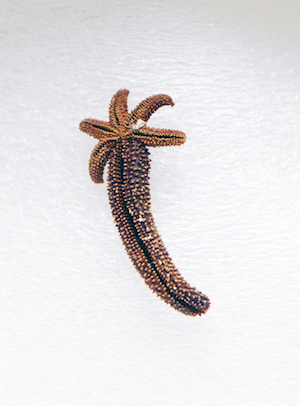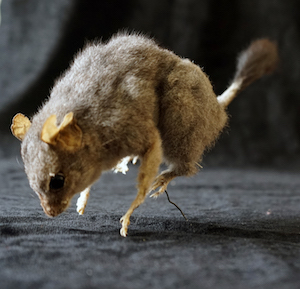Review: The Tissue Culture and Art Project review, “Biomess” ·
Art Gallery of Western Australia ·
Review by Miranda Johnson ·
Currently on show at the Art Gallery of Western Australia is “Biomess”, an exhibition that examines the possibilities that arise when combining the biological sciences with artistic practice. Collaborative duo Oron Catts and Ionat Zurr make up The Tissue Culture and Art Project, and have been researching bioart, at the intersections of art and science, since 1996. The pair also run SymbioticA Lab, based at the University of Western Australia, which hosts a continuous array of international and local artists, scientists and researchers.
Biomess brings to the fore the occasionally sticky ethical and theoretical implications to the developments in biological science that allow for the creation of new forms of life. The exhibition displays living and dead organisms from the Western Australian Museum’s collection, as well as a deconstructed bioreactor capable of making hybridoma cells, or the fusion of cells from multiple organisms. The artists seek to challenge viewers’ understandings of the fundamental categories of life, death and procreation; and to point out that common understandings of these categories are incredibly limited.

The exhibition consists of a series of slick black and glass cases, lit from below to illuminate the various creatures and objects inside. Animals as diverse as Byrne’s geckos, the mollusc nudibranch, bearded dragons, a taxidermy emu and a live axolotl are on display, variously displayed in water tanks, laid out and stuffed, or piled into buckets and tubs. Significant is that the didactic information is displayed some distance from the cases, leaving the viewer to wander and wonder, and ultimately arrive at their own conclusions about how each creature came to be displayed thus so. The information provided does contribute heavily to engaging with the exhibition’s premise but keeping this information separate from the display cases provides a certain level of distance. The didactic panels, once found, provide a multitude of information regarding the specific curiosities of each animal – Byrne’s geckos, for example, can clone themselves without need of a mate, nudibranchs are hermaphroditic, and axolotls are able to regenerate their body parts. It’s incredibly satisfying – and fascinating – to read about the diversity and quirkiness of life – which is, in all senses of the word, extremely queer.
Mirroring the cases on the other side of the gallery is the large deconstructed bioreactor, containing a jar of hybridoma cells, fused from two separate sources – an entirely human-constructed form of life that defies current forms of classification. This bioreactor gestures towards the possibilities of future scientific research, juxtaposed against the animals displayed in the cases, which are already and have always defied and challenged our understanding of the processes of life, death, gender and procreation, though we didn’t always know it. In this way, the exhibition, taken as a whole, questions the way we classify living matter, as well as the impact of human intervention on “natural” processes – is it natural for a beetle to want to mate with a man-made beer bottle to the point of near extinction of its species? Biomess suggests that the natural is, and always has been, open to interpretation; manipulated and muddled, as humans and non-humans alike respond to their environments, evolve and adapt.

The Tissue Culture & Art Project,
Collection, Western Australian Museum.
However, circling the cases once again, I felt that in this lab (and gallery), this flourishing of life felt more clinical, the curious and the challenging stripped, stuffed and laid out. Of course, it’s meant to be clinical in a corporate sense, the cases deliberately designed to imitate the clean lines and fetishistic displays of luxury branding, except with a taxidermy parrot lying inside, rather than a Chanel handbag. I was aware that this was a comment on the corporate interests that have the power to sway scientific research and commodify life, but at the same time, by reproducing these formats with little intervention, its critique is somehow softened.
This feeling resonates when considering the presence of live animals in a gallery space. Of course, live animals are used in scientific research all the time, in many awful ways, and the signs prominently displayed at the entrance to the exhibition reassure visitors that the live animals shown here are monitored daily by specialist handlers, yet it’s worth asking whether that’s enough. Monitoring is different to thriving, and I felt decidedly uncomfortable as I watched the axolotl hiding behind the single rock in its otherwise bare tank. But at the same time, my lack of specialist knowledge leaves me unsure as to what kind of environment the axolotl would prefer – a feeling, I expect, that is shared by other visitors from non-scientific backgrounds. It’s clear from this exhibition that we have much to learn about the so-called natural world, and the ways in which scientific practices, corporate interests, and everyday existence are entangled.
“Biomess” runs at the Art Gallery of WA until December 3, as part of “Unhallowed Arts”.
Read an interview with Oron Catts, about SymbioticA, “Unhallowed Arts” and “Biomess”.
Pictured top: Oron Catts & Ionat Zurr, Land Snails – Biomess 2018 (detail), The Tissue Culture & Art Project Collection, Western Australian Museum.
Like what you're reading? Support Seesaw.






